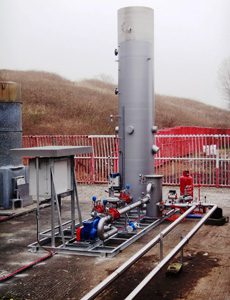
Landfill support firm Biogas Technology has demonstrated a successful new low-calorific flaring solution to manage diminishing methane gas emissions on closed landfill sites.
The innovative low-calorific gas flare has been successfully piloted as part of the ACUMEN (Assessing, Capturing and Utilising Methane from Expired and Non-operational landfills) project, which is funded by the EU Life+ environment programme.
The new technology was trialled at Liverpool City Council’s Otterspool landfill site, a closed site where the landfill gas supply is no longer sufficiently rich or plentiful to sustain utilisation or combustion via a ‘standard’ flare.
Biogas Technology are partners in the ACUMEN project, alongside the Environment Agency, the Department of Energy and Climate Change, the Department for Environment Food and Rural Affairs, Norfolk County Council, Warsaw University of Technology, and Ground-Gas Solutions. The three-year project was completed in August 2015.
A major problem facing ageing expired landfill sites is that when the methane content of gas falls below 20%, standard gas flares can have difficulty in achieving sustainable and safe combustion. Biogas Technology has developed a specially adapted low-calorific flare that can effectively and safely burn gases below this methane concentration.
The 45 hectare Otterspool site, which had previously housed a 3MW gas utilisation scheme, was using a large, standard landfill gas flare that was approaching the end of its useful life. Biogas Technology developed and installed its new type of low-calorific flare. This uses a specially designed new burner technology that is able to achieve stable combustion on very lean and variable landfill gas flows.
Extending flaring into new domains
The new technology is capable of operating over a wider range of gas qualities and quantities than traditional low-calorific flares. This includes combusting landfill gas with methane concentrations as low as 8%, without carbon intensive support fuels such as propane or butane.
Over a 12 month period the demonstrator project reduced Otterspool’s carbon footprint by 19,600 tonnes, equivalent to the environmental benefit of removing 6,533 cars from the road It has also achieved cost savings in excess of £9,000 due to reduced power consumption from using smaller and more efficient motors and variable speed drive technology.
Demonstrating performance parity with existing technologies
During the demonstration period, six rounds of investigative emissions monitoring were carried out on the flare at Otterspool. This showed that the low-calorific flare could attain the same low exhaust emissions as more established technologies in a wide range of operational parameters.
The low calorific flare is configured for landfill gas flows from 40 to 300 m3 hr and methane concentrations of 8 to 65% and can achieve turn-down ratios of up to 10:1. The flare can also be configured for larger or smaller gas flows using different stack heights and diameters, and different burner head configurations.
The Otterspool demonstration project has been evaluated by technical experts from ACUMEN. The final report concluded: “Given the stable performance of this flare at very low flows and low methane concentration, this technology opens the prospect of active thermal oxidation of methane at managed landfills for a much greater proportion of a landfill’s total lifecycle. It would be important on sites requiring active gas management, for example, to control underground gas migration.”
Potential for legacy landfill sites
Ian Gadsby, Managing Director of Biogas Technology, said: “In 2012, UK landfills emitted 881,000 tonnes of methane, which accounts for almost 3% of total UK greenhouse gas emissions. There are approximately 20,000 closed landfill sites in the UK and an enormous legacy of expired sites across the wider European Union. Our low-calorific flare has huge potential to reduce methane emissions at sites where utilisation and traditional flaring technologies are no longer viable, but where there is still a need to comply with environmental regulations.”
Biogas Technology has developed a new low-calorific flare, based around the design of its ACUMEN prototype, and is partnering with UK landfill companies to provide a cost effective and reliable replacement for older and larger flares. This will ensure that landfill owners remain compliant with site licenses and Environment Agency guidance for the next 20 years.
The ACUMEN project demonstrated new techniques and technologies to improve the capture and use of methane from closed and historic landfills. In addition to Biogas Technology’s low-calorific gas flare, this included small scale gas engines (8-150 kW) and an active biological oxidation technique.
The findings have been published in a final ACUMEN Project Report, which provides practical guidance, including access to various online tools to help landfill owners assess options for managing methane.







